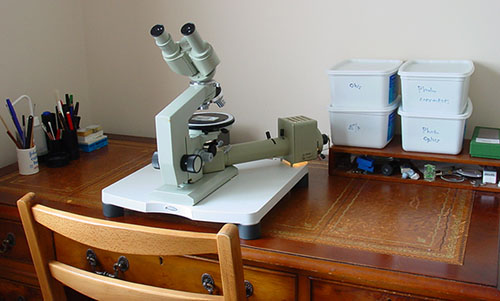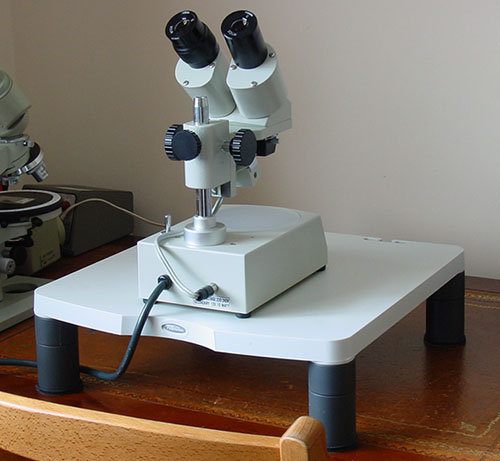
|

|
Topical
Tips 14
Using computer
monitor stands for microscopes.
by David Walker, UK
The eyepiece height of microscopes can vary quite considerably between models; this can be frustrating for the enthusiast who may own a variety of examples of various vintages and designs. The larger laboratory microscopes may place the eyepiece(s) too high in a domestic environment, possibly requiring a reduced height table or adjustable height chair whereas the smaller student or older research models may be too low, even for the lowest height setting on an office chair. The author's Russian LOMO Biolam comes into this latter category and more so my Meiji stereo microscope, as stereos that hobbyists often use can be quite low, inviting poor posture when viewing.
The enthusiast with woodworking or metalworking skills can put together a customised stand for each microscope owned but less easy for those without such skills or facilities but seeking something 'off the shelf'. In the past I've used various bodges to get two or more microscopes on a table to the same comfortable viewing height, including the far from ideal book of an appropriate depth to the more workable but inelegant house brick wrapped and sealed in cardboard!
The author has recently started using a redundant computer monitor stand for a microscope and has found it works well. Although plastic they are strongly braced as they are designed to take the up to 18 kg load typical of modern 17 inch monitors. They usually come with a set of adjustable supports to vary the height, typically, to three levels, so offer quite a degree of height control. The stand model the author used was made by 'Fellowes' available from office supply shops such as 'Staples' for ca. £16. The corner supports each have a rubber ring for the base so give additional rigidity. A bonus is that a dust free area under the microscope is created which is handy for storage of items in use during a microscopy session, e.g. slides, spare objectives and eyepieces.
The working area is quite large e.g. sufficient for external or bulkier connected lamps such as that shown on the Biolam below. The monitor stands also seem sturdy enough for most undemanding photomicrography especially as the trend moves towards lightweight digital cameras for photomicroscopy. Although the author prefers to remove the Biolam microscope from the shelf for a photomicroscopy session to allow easy manipulation of a digital camera on the taller photomicroscopy set-up.
Comments
to the author
Dave
Walker
are welcomed.
Russian Biolam being used wth OI-35 lamp on monitor stand. Used ice cream containers are put to good use to store eyepieces, objectives and photo kit. (In the objective container is a cut to fit old mouse mat with an array of holes punched out the diameter of the RMS thread to keep the objectives secure). The wooden tray on the right is the carcass of an old stereo tuner to store bits and pieces.
The author's check for comfortable viewing height is to sit on the chair in a relaxed (not bolt upright) posture with eyes lowered, then bringing yourself to the microscope should ideally place the eyepieces at eye level without further movement.
Space can be at a premium in a domestic environment. Rather than buy a second monitor stand, for a dedicated stereo microscope session the compound microscope can be quickly put to one side and the monitor stand height increased for comfortable extended viewing with the smaller stereo.
Please report any Web problems or offer general comments to the Micscape Editor.
Micscape is the on-line monthly magazine of the Microscopy UK web site at Microscopy-UK